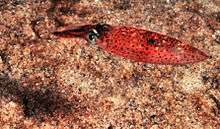Ommastrephidae
| Ommastrephidae | |
|---|---|
 | |
| Lesser flying squid (Todaropsis eblanae) | |
| Scientific classification | |
| Kingdom: | Animalia |
| Phylum: | Mollusca |
| Class: | Cephalopoda |
| Order: | Teuthida |
| Suborder: | Oegopsina |
| Family: | Ommastrephidae Steenstrup, 1857 |
| Subfamilies | |
|
Illicinae
| |
Ommastrephidae is a family of squid containing three subfamilies, 11 genera, and over 20 species. They are widely distributed globally and are extensively fished for food. One species, Todarodes pacificus, comprises around half of the world's cephalopod catch annually.[1]
Some members of Ommastrephidae (volplaning species) are known to have the ability to glide out of water, earning them the common name of "flying squid".[2]
Description

The Ommastrephids are small to large squids, with mantle lengths ranging from that of the glass squid (Hyaloteuthis pelagica) at 9 cm (3.5 in),[3] to the Humboldt squid (Dosidicus gigas) at 1.5 m (4.9 ft).[4] The mantle narrows towards the back and possesses large terminal fins.[5] The family is characterized by an inverted T-shaped funnel locking cartilage.[2][5] They have an easily recognizable, slender, feather-shaped gladius with a hollow cone structure (the primary conus). Light organs (photophores) are present along the head and mantle of members of the subfamily Ommastrephinae.[2][5]
Ommastrephid arms have a double series of suckers. The enlarged tips (the clubs) of the tentacles have four rows of suckers, except in the genus Illex, which has eight. Hooks are absent. One of the ventral arms develops into a secondary sexual organ (the hectocotylus) in males.[1]
All ommastrephids are active predators. Their arms and tentacles bear sharp teeth and are used to grasp and bring prey to their beaked mouths.[6] They are very strong swimmers, and some species are known to glide out of water to escape predators.[2]
Ommastrephid paralarvae are distinctive for having fused tentacles, looking like a single "proboscis". It gradually splits into two as the paralarvae grow becoming completely separated once they reach mantle lengths of 5 to 10 mm (0.20 to 0.39 in).[2][6]
Distribution and habitat
Ommastrephids usually occur in pelagic waters, but can also be found in neritic habitats.[2] They are found worldwide.[1][6]
Taxonomy

(Illex illecebrosus)

(Dosidicus gigas)
%2C_Northern_Hawaiian_waters.jpg)
(Ommastrephes bartramii)

(Martialia hyadesii)

(Todarodes pacificus)
Ommastrephidae was first established by the Danish zoologist Japetus Steenstrup in 1857. It is classified under the suborder Oegopsina of the order Teuthida (squids). It is divided into three subfamilies - Illicinae, Ommastrephinae, and Todarodinae; further subdivided into 11 genera and more than 20 species.
These subfamilies, genera, species, and subspecies are classified under Ommastrephidae:
- Family Ommastrephidae
- Subfamily Illicinae
- Genus Illex
- Illex argentinus, Argentine shortfin squid
- Illex coindetii, southern shortfin squid
- Illex illecebrosus, northern shortfin squid
- Illex oxygonius, sharptail shortfin squid
- Subfamily Ommastrephinae
- Genus Dosidicus
- Dosidicus gigas, Humboldt squid, jumbo flying squid or jumbo squid
- Genus Eucleoteuthis
- Eucleoteuthis luminosa, striped squid or luminous flying squid
- Genus Hyaloteuthis
- Hyaloteuthis pelagica, glassy flying squid
- Genus Ommastrephes
- Ommastrephes bartramii, neon flying squid or red flying squid
- Genus Ornithoteuthis
- Ornithoteuthis antillarum, Atlantic bird squid
- Ornithoteuthis volatilis, shiny bird squid
- Genus Sthenoteuthis
- Sthenoteuthis oualaniensis, purpleback squid or purpleback flying squid
- Sthenoteuthis pteropus, orangeback squid or orangeback flying squid
- Subfamily Todarodinae
- Genus Martialia
- Martialia hyadesii, sevenstar flying squid
- Genus Nototodarus
- Nototodarus gouldi, Gould's flying squid
- Nototodarus hawaiiensis, Hawaiian flying squid
- Nototodarus sloanii, Wellington flying squid or New Zealand arrow squid
- Genus Todarodes
- Todarodes angolensis, Angola flying squid
- Todarodes filippovae, Antarctic flying squid
- Todarodes pacificus, Japanese flying squid or Japanese common squid
- Todarodes sagittatus, European flying squid
- Genus Todaropsis
- Todaropsis eblanae, lesser flying squid
See also
References
- 1 2 3 John H. Wormuth (1976). "Ommastrephidae: Flying Squids". In P. Jereb; C.F.E. Roper. Cephalopods of the World: An annotated and illustrated catalogue of cephalopod species known to date . Vol. 2, Myopsid and Oegopsid Squids (PDF). 2. Food and Agriculture Organization of the United Nations. pp. 9–10.
- 1 2 3 4 5 6 Richard E. Young, Michael Vecchione, and Martina A. Compagno Roeleveld (ca. 1946-2006) (2010). "Ommastrephidae Steenstrup 1857. Version 27 June 2010.". The Tree of Life Web Project. Retrieved January 5, 2012.
- ↑ Nesis, K. N. 1982. Abridged key to the cephalopod mollusks of the world's ocean. 385,ii pp. Light and Food Industry Publishing House, Moscow. (In Russian.). Translated into English by B. S. Levitov, ed. by L. A. Burgess (1987), Cephalopods of the world. T. F. H. Publications, Neptune City, NJ, 351pp.
- ↑ Glaubrecht, M. & M.A. Salcedo-Vargas 2004. The Humboldt squid Dosidicus gigas (Orbigny, 1835): History of the Berlin specimen, with a reappraisal of other (bathy-)pelagic gigantic cephalopods (Mollusca, Ommastrephidae, Architeuthidae). Zoosystematics and Evolution 80(1): 53–69.
- 1 2 3 John H. Wormuth (1976). The biogeography and numerical taxonomy of the oegopsid squid family Ommastrephidae in the Pacific Ocean. University of California Press. pp. 9–10. ISBN 978-0-520-09540-3.
- 1 2 3 K. L. Lamprell, J.M. Healy, A.M. Scheltema, K. Gowlett-Holmes & C.C. Lu (2001). Zoological Catalogue of Australia. Vol. 17.2, Mollusca: Aplacophora, Polyplacophora, Scaphopoda, Cephalopoda. CSIRO Publishing. p. 274. ISBN 978-0-643-06707-3.
External links
| Wikimedia Commons has media related to Ommastrephidae. |
| Wikispecies has information related to: Ommastrephidae |
- CephBase: Ommastrephidae
- Ommastrephidae discussion forum at TONMO.com
- Tree of Life web project: Ommastrephidae
- Scientific American: Can a Squid Fly Out of the Water?